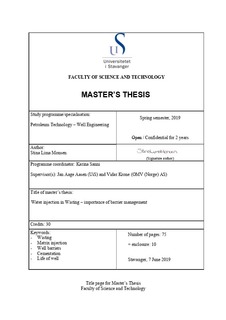| dc.contributor.advisor | Sanni, Karina | |
| dc.contributor.author | Monsen, Stina Lima | |
| dc.date.accessioned | 2019-12-19T12:06:10Z | |
| dc.date.available | 2019-12-19T12:06:10Z | |
| dc.date.issued | 2019-06-07 | |
| dc.identifier.uri | http://hdl.handle.net/11250/2634136 | |
| dc.description | Master's thesis in Petroleum engineering | nb_NO |
| dc.description.abstract | A preselected Wisting well injector design has been used as a basis for this study. Because of the challenges following an ultra shallow reservoir and an almost negligible stress contrast between the reservoir and cap rock, the objective of the thesis has been to study the effect of the cement around the 9 5/8” liner, set in the reservoir. As a consequence, the packer placement, and hence the injection point, was changed accordingly. The well completion and well barriers were studied, with focus on two scenarios: fully cemented liner and non- cemented liner.
Due to the impact the annulus cement has on the barrier system, the two scenarios were evaluated in coherence with P&A operations, both temporary and permanent. Sketches were made and discussed, based on the original well design and the requirements and guidelines of the NORSOK Standard D-010 (2013).
To find the cementing services that fit the Wisting environment best, different cement types and cement evaluation tools from Schlumberger and Baker Hughes GE has been studied and evaluated. The service providers were contacted to discuss and obtain as good and useful information as possible.
The objective of the water injector is to be able to maintain matrix injection for as long as possible, due to the risk of potential fractures entering the cap rock. This risk increases significantly with a non-cemented liner. Fractures have therefore gained much focus, both in the theory section and in the simulation section. Many parameters change, both vertically and horizontally, and they are influencing the fractures and the injection. The effect of these parameters has therefore been simulated.
It was concluded that the cement as a barrier has a great impact on the performance of the injection well, and that a low-density cement slurry, in addition to a cement bond logging tool, would be the safest alternative in this type of injection well to ensure a successful cement job. | nb_NO |
| dc.language.iso | eng | nb_NO |
| dc.publisher | University of Stavanger, Norway | nb_NO |
| dc.relation.ispartofseries | Masteroppgave/UIS-TN-IEP/2019; | |
| dc.rights | Navngivelse 4.0 Internasjonal | * |
| dc.rights.uri | http://creativecommons.org/licenses/by/4.0/deed.no | * |
| dc.subject | petroleumsteknologi | nb_NO |
| dc.subject | boreteknologi | nb_NO |
| dc.subject | Wisting | nb_NO |
| dc.subject | matrix injection | nb_NO |
| dc.subject | well barriers | nb_NO |
| dc.subject | cementation | nb_NO |
| dc.subject | life of well | nb_NO |
| dc.title | Water Injection in Wisting - importance of barrier management | nb_NO |
| dc.type | Master thesis | nb_NO |
| dc.subject.nsi | VDP::Technology: 500::Rock and petroleum disciplines: 510::Petroleum engineering: 512 | nb_NO |

